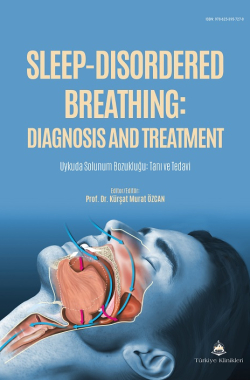SCORING SLEEP STAGES IN POLYSOMNOGRAPHY
Duygu Erdem1 Kürşat Murat Özcan2
1Bülent Ecevit University, Faculty of Medicine, Department of Otorhinolaryngology, Zonguldak, Türkiye
2Ankara Bilkent City Hospital, Department of Otorhinolaryngology, Ankara, Türkiye
Erdem D, Özcan KM. Scoring Sleep Stages in Polysomnography. In: Özcan KM, editor. Sleep-Disordered Breathing: Diagnosis and Treatment. 1st ed. Ankara: Türkiye Klinikleri; 2025. p.67-75.
ABSTRACT
Numerous different sleep disorders, encompassing various disciplines, have been identified. Sleep-disordered breathing is the most common among all sleep disorders. For sleep-disordered breathing and some other sleep disorders, sleep tests are required for diagnosis, depending on the patient’s clinical condition. Among sleep tests, polysomnography performed in the sleep laboratory is considered as the gold standard to evaluate the patient’s sleep. Experienced and trained sleep laboratory personnel must then manually score data obtained from the overnight test. In polysomnography, electroencephalography, electrooculography, and electromyography data are recorded to assess the patient’s sleep. When evaluating these recorded data, the sleep stages are first scored. Scoring is performed according to the internationally accepted rules outlined in the guidelines of the American Academy of Sleep Medicine. Sleep stages are scored in 30-second bursts called epochs. The appropriate sleep stage for each epoch is determined. Electroencephalography (EEG) wave characteristics and specific EEG patterns are used as the basis for determining which sleep stage to assign to an epoch. Electrooculography and electromyography data are also evaluated in conjunction with EEG characteristics. Alpha waves with a frequency of 8-13 Hz are evaluated in the EEG recording to determine awake status. If alpha waves constitute more than half of the epoch, the epoch is scored as awake. During Stage 1 sleep, the EEG recording consists of low-amplitude mixed-frequency waves. During Stage 2 sleep, the EEG typically shows EEG patterns called sleep spindles and K complexes. Sleep spindles are waves with a frequency of 11-16 Hz that last at least 0.5 seconds. The K complex is a biphasic wave pattern lasting at least 0.5 seconds. It begins with a rapid positive peak and then develops a slower, broader negative peak. Delta waves are typical for stage 3 sleep. Delta waves have an amplitude of at least 75 microvolts and a frequency of 0.5-2 Hz. If delta waves constitute more than 20% of the epoch, the epoch is scored as stage
3. During REM sleep, low-amplitude, mixed-frequency EEG waves, along with rapid eye movements and low muscle activity, are observed. The distribution of sleep stages and their relationship to the respiratory events observed during these stages aid in making decisions for diagnosis and treatment.
Keywords: Sleep stages; Diagnosis; Sleep, REM; Polysomnography; Sleep apnea syndromes
Kaynak Göster
Referanslar
- Troester MM, Quan SF, Berry RB, Plante DT, Abreu AR, Alzoubaidi M et al. for the American Academy of Sleep Medicine. The AASM Manual for the Scoring of Sleep and Associated Events: Rules, Terminology and Clinical Speci fications. Version 3 Darien, IL: American Academy of Sleep Medicine. 2023. [Crossref] [PubMed] [PMC]
- Chylinski D, Berthomier C, Lambot E, Frenette S, Bran dewinder M, Carrier J et al. Variability of sleep stage scoring in late midlife and early old age. J Sleep Res. 2022 Feb;31(1):e13424. [Crossref] [PubMed]
- Sigurdardottir HL, Gjerde R, Stiris MG, Skranes J. Validation of manually scored multichannel frontal electroencephalography against full polysomnography in a pediatric cohort. J Sleep Res 2025;34(1):e14208. [Crossref]
- Gonzalez AA. Sleep Stage Scoring, Medscape Tools & Reference (Neurology). 2019. retrived June 25, 2025.
- American Academy of Sleep Medicine. The AASM Manual for the Scoring of Sleep and Associated Events: Rules, Terminology and Technical Specifications. Summary of Updates in Version 3. 2023. [Crossref]
- Follin LF, Zahid AN, Viste R, Vevelstad J, Kaufmann T, Ramm-Pettersen A et al. An inter-rater variability study between human and automatic scorers in 5-s mini-epochs of sleep. Sleep Med. 2025;128:139-150. [Crossref] [PubMed]
- Pitkänen M, Pitkänen H, Nath RK, Nikkonen S, Kainulainen S, Korkalainen H et al. Temporal and sleep stage-dependent agreement in manual scoring of respiratory events. J Sleep Res. 2025;34(3):e14391. [Crossref] [PubMed] [PMC]
- Mogavero MP, Congiu P, Lanza G, Ferini Strambi L, Marelli S, Castelnuovo A, et al. Age-related changes in large muscle group movements during sleep. J Sleep Res. 2025;34(4):e14447. [Crossref] [PubMed]
- Xu Y, McInnes A, Kao CH, D’Rozario A, Feng J, Gong P. Spatiotemporal dynamics of sleep spindles form spiral waves that predict overnight memory consolidation and age-related memory decline. Commun Biol. 2025;8(1):1014. [Crossref] [PubMed] [PMC]

